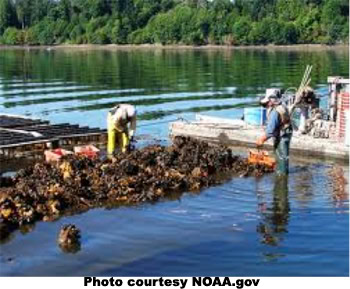
Time To Give Mussels A Try!
Sylvia Geiger, MS, RD
Sylvia is a food and nutrition consultant with a broad background in culinary nutrition. She approached nutrition through food and has spent years in the kitchens of colleges and hospitals serving fresh and healthy food to thousands of customers. She has been an adjunct faculty member in the Department of Nutrition and Food Sciences at the University of Vermont since 1993 and for the past four years has been working as a dietitian in Price Chopper Supermarkets. Her newest endeavor is her blog where she is on a journey to learn everything about cooking & enjoying seafood and how fish makes its way from the water to our tables. You can join her on this journey by visiting her blog or following her on Twitter @sylviamgeiger.
When it comes to balancing a love of seafood with nutrition, health and sustainability, only a handful of choices successfully run the gauntlet of cooks, nutritionists, and environmentalist. Mussels are in that category. Not only are these bivalves delicious and easy to prepare, they are nutrition powerhouses that actually improve the waterways in which they are raised and harvested.
As a nutritionist, I highly recommend that you give mussels a try. A three-ounce serving of cooked mussels (equal to half a pound in-shell) serves up: 20 grams protein, 736 mg of omega-3 fats, while providing an excellent source of vitamin C, vitamin B12, iron, selenium and ribo avin all for under 150 calories.
You’ll find fresh mussels in one or two pound mesh sacks at the grocery store, usually packed in ice. Fresh mussels are live and the shells should close when touched or run under cold water; discard any that don’t. Mussels are extremely easy to prepare. Most come pretty clean, but I usually scrub them briefly under running water and cut of the brown beards that are sticking out of the shells. Once cleaned, they cook up quickly Less than ten minutes, and can be served in or out of their shells. I prefer to leave them in their shells, and serve them in a shallow soup bowl with some crusty toasted garlic-parmesan bread to sop up the cooking juices. For plenty of quick and easy mussel recipes go to EatingWell.com. The steamed mussels in tomato broth shown below are done in less than 20 minutes.
Mussels are a prominent ingredient in many Mediterranean fish dishes. When I was in Barcelona Spain last year, Mejillones a la Marinera or Mussels in White Wine Sauce became my favorite dish. Here is my version of this classic recipe.
Ingredient:
3 tablespoons olive oil
1-2 cloves garlic, minced
1 onion or 2-3 shallots, minced
2 tomatoes, quartered and smashed
1 tablespoons paprika, preferably sweet Spanish pimento
½ teaspoon hot pepper flakes
1 cup white wine
3 pounds cleaned mussels (discard any mussels that do not close)
Salt and fresh ground pepper to taste
¼ cup parsley, preferably flat leaf, coarsely chopped
Directions:
In a stockpot, heat the oil and sauté the onion, garlic until golden. Add the tomatoes, paprika, red pepper flakes and cook for a minute more.
Add the wine, mussels, salt and pepper. Cover and turn up the heat.
After 3-4 minutes, check the pot to see if the mussels have opened; shake the pot to move the mussels around. If most of the mussels have opened, turn the heat to low.
Cook for another 5 minutes until all the shells are open. Note: there are usually one or two shells that don’t open; these should be discarded.
Serve in a soup bowl garnished with chopped parsley and with toasted garlic-parmesan bread: slice a baguette and rub each slice with crushed garlic, drizzle with olive oil and grated Parmesan cheese and toast until golden brown in a medium hot oven.
Why environmentalists love mussels
The New England Aquarium, and just about every other marine conservation group, considers mussels to be one of the most environmentally friendly forms of aquaculture. Mussels are bivalves, and all bivalves are filter feeders that actually clean the water by feeding on particulates and tiny organisms. This clarifies the water, allowing deeper sunlight penetration, which helps rejuvenate the marine ecosystem and oxygenates the waters. In addition, mussels help lower overall nitrogen levels, a problem in many costal ecosystems, by converting it to animal protein.
Most of the mussels sold in US supermarkets come from Canada, New England or Washington State. These small regional aquaculture farmers collect wild larval mussels (or spat), which attach themselves to collection ropes hung close to shore. Once collected, the spat are moved to grow-out ropes or mesh socks further of shore. No further inputs (feed, hormones, or antibiotics) are needed and about 12 to 18 months later the mussels can be harvested. About 12 grow-out ropes yield approximately 180,000 pounds of mussels! So support your US aquaculture farmer give mussels a try.








Leave a comment